
Station Name: BLACKHEATH HILL including Blackheath Hill Tunnel[Source: Nick Catford]
Blackheath Hill Station was sited in a deep cutting on the south side of Blackheath Hill and after leaving the station for Greenwich trains immediately entered a short brick-lined tunnel under the A2 (Blackheath Hill); it was 55yd in length.
After closure, the station building was used by the ‘Services Remembered Club’ from 1921 and from 1929 it housed the ‘MacCormack Billiard Club’ which became the ‘Blackheath Billiard Club’ in 1931. The billiard club remained there until the outbreak of war in 1939 when the station was leased to the Helliot Machine Tool Company which was involved in war work. On the north side of Blackheath Hill, the tunnel extended for a short distance before opening into a deep cutting. There were shops on the north side of Blackheath Hill, with houses on the east side of Plumbridge Street which runs parallel with the railway line on its west side. At some time after closure of the line, a concrete floor was laid through the tunnel forming a large underground work space. It is unclear what this underground area was initially used for, but the 1927 Kelly’s directory lists a company called Express Cable & Engineering in Plumbridge Street. This was the only business shown so it seems likely that it might have occupied the tunnel from this date. By the mid-1930s there was a builder’s yard on the course of the railway line on the north side of Blackheath Hill and this company used the tunnel to store breeze blocks.
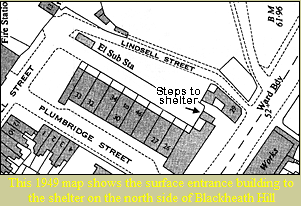
On 17 June 1940, the tunnel was leased to Greenwich council by the Southern Railway for use as an air raid shelter. This conversion was approved by the Ministry of Home Security on 11 July 1940 and the total cost of the conversion was £394 plus £80 for temporary works. It was known as the Blackheath Hill Shelter, with access from Lindsell Street and Sparta Street plus a set of steep steps down from Blackheath Hill to a midway point within the shelter. The main entrance to the shelter was from Sparta Street from where there was a short walk along the infilled cutting and down a gentle slope into the shelter (the slope was later replaced by a series of wide steps). Chemical toilet cubicles were sited at the entrance and just inside the tunnel there was a small canteen, kitchen and first aid post. The internal walls were whitewashed. A second set of chemical toilets was later proposed for the Lindsell Street entrance but these were considered unnecessary as those at the Sparta Street entrance were considered adequate. The shelter was always damp and was fitted with an electric heater in January 1943. By this time the shelter was usually referred to as the Sparta Street Shelter.
By 1949 the houses on the east side of Plumbridge Street and the shops along Blackheath Hill had been demolished and replaced by a four-storey block of flats above shops in Plumbridge Street. This building extended along Blackheath Hill as a two-storey block with a single-storey extension at its east end accessed from the service road at the back of the shops in Plumbridge Street; from here there were steps down into the railway tunnel which was now back in industrial use. After the war, the Helliot Machine Tool Company used the tunnel as a machine shop. Access into the tunnel was from the rear of the now much altered station building which was its office. At the rear of the building there was an open balcony which was, in fact, part of the original footbridge linking the two platforms. The cutting had been largely infilled but a ramp down into the tunnel had been built to maintain access. When visited by railway historians O J Morris and J Pelham in 1956 and 1957, the stairs, retaining walls and the north end of the platforms were still visible and a number of hand-painted railway signs could still be made out on the walls. In 1958, the Helliot Machine Tool Company moved to Greenwich Church Street and after remaining unused for several years the station and tunnel were occupied by R Taylor & Co Machine Tools from 1966. The company is no longer listed after 1969, but strangely the 1973 Kelly’s Directory lists the Helliot Machine Tool Company back in occupation. From 1973 the site was occupied by a husband and wife team, Alan and Margaret Storey trading as Magnal Laminations and W A Storey (Plastics) Ltd. The company made road signs for local authorities. Many road signs in use today were either made by or designed by this company. They were the first people to standardise signage, lighting of signs and provide a catalogue of replacement parts. Alan Storey also pioneered the reflective sign and in conjunction produced the Universal clip, which was also made in the underground factory. The tunnel was used as their workshop and housed welding equipment, a cutting machine and a vacuum machine; the surface building was their office and silk screen shop; the company had 15 employees. The station site was sold to a property developer in 1986 and W A Storey moved to Peckham and ceased trading the following year following the death of Alan Storey. The station building remained empty for a year and was demolished in 1987 to make way for a new housing development called Robinscroft Mews. Worried that the new development might subside into the tunnel, the southern portal was fully excavated and the north ends of the platforms were exposed, wooden shuttering was placed across the portal and the excavation was backfilled with concrete. The tunnel was visited by the author in March 2008. At this time, the two-storey brick building on Blackheath Hill was empty and available to let; the last occupier had been the Regency Bakers. The main access into the building is from Plumbridge Street with a delivery entrance in the single-storey extension accessed from the service road behind the shops. There is a second set of double doors adjacent to this goods entrance which opens onto a flight of concrete steps going down 14ft to a short passage. At the end of the passage a wooden door opens into the tunnel. The remaining section of the twin-track brick-lined tunnel is 92ft in length and 26ft wide with two safety recesses in the side walls. At the north end, a concrete raft cuts through the tunnel to support the building above. There are several fluorescent light fittings fixed to the roof dating from the 1960s. The brickwork has been painted, but where one of the light fittings has become detached the original soot covering the tunnel roof can be seen. 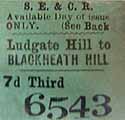
At the north end of the tunnel metal rails can be seen in the concrete floor. The distance between them is 4ft 8 ½in (standard gauge). This cannot be a section of original railway track as the present floor is several feet above the original track level. It used to be common practice to lay rails for moving heavy metal wheeled trolleys for jobs in machine shops, often using standard gauge axles which were easy to buy second hand. This could account for these rails and would make sense as it would appear there has never been overhead gantry in the machine shop / tunnel. At the southern portal the wooden shuttering and the concrete infill behind it can clearly be seen. Financial problems delayed construction until 1871 when the branch opened as far as Blackheath Hill on 18 September with one intermediate station at Lewisham Road; a second at Brockley Lane was opened in June 1872. There was a regular 45-minute service although most trains shuttled between Nunhead and Blackheath Hill which was unpopular with commuters who had to change at Nunhead to reach central London. Despite disappointing receipts, the LCDR continued with its proposal to extend to Greenwich. The original powers had lapsed and a new Act was required which was received in 1881. The company was still in financial difficulty and the extension was not completed to Greenwich Park (Greenwich until 1900) until 1 October 1888. A substantial terminus was built in Stockwell Street and not Crooms Hill as originally planned because housing development had overtaken the railway. The extension failed to attract additional traffic to the line which was unable to compete with SER's direct line from Greenwich into central London. Leisure traffic was more successful, however, with the branch providing a convenient route to Crystal Palace, a major tourist destination in South London. With the amalgamation of the LCDR and SER in 1899, Greenwich was renamed Greenwich Park to avoid confusion and with the introduction of electric trams from 1908 it was soon clear that the line could never make a profit. A push-and-pull service was introduced in 1913 in an attempt to cut losses and by the start of WW1 a 20-minute peak hour service and 45-minute off peak service was being maintained. Both the Greenwich Park and Crystal Palace branches were closed on 1 January 1917 as a wartime economy measure; the Crystal Palace service was reinstated in 1919 but the Greenwich Park branch never reopened. After closure, the line remained open for freight traffic as far as Brockley Lane, and the section between Brockley Lane and Lewisham Road was used for carriage storage. There was a proposal to electrify the line and reopen it but this was quickly dropped. 
In 1927 Southern Railway refurbished the section of line between Nunhead and Lewisham Road as part of a scheme to improve freight operations in the locality; this involved building a spur down to join the Mid Kent line between St Johns and Lewisham; at the same time the track was re-ballasted and re-laid, opening on 7 July 1929. The remaining severed section of the branch between Lewisham Road and Greenwich Park was formerly abandoned by Act of Parliament in 1929.The new loop line carried a number of freight services in the area and it was electrified in 1935. Passenger trains began using the loop on 30 September 1935, with a peak-hour service between Dartford and St Paul's (Blackfriars) taking the pressure off the overcrowded services into Cannon Street and Charing Cross. This passenger services was withdrawn on 16 October 1939 as a wartime economy measure but was reinstated on 12 August 1946. Today the loop line forms an important part of SouthEastern rail network with two trains an hour in each direction running between Dartford and Victoria. Since the line reopened in 1929 there has been no suggestion that the two intermediate stations at Brockley Lane and Lewisham Road should be reopened. Ticket from Michael Stewart Sources:
See also:Nunhead, Brockley Lane, Lewisham Road 10.jpg) Blackheath Hill station looking north-east in the mid 1920s before the line was officially abandoned. The 55yd tunnel can be seen beyond the station.
Photo from John Mann collection  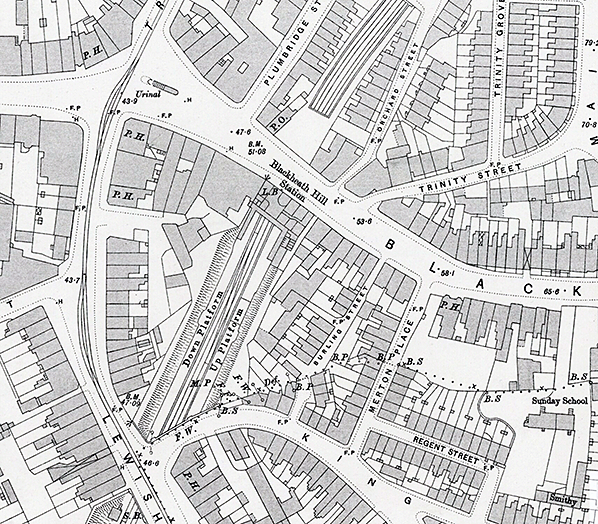
1896 1:1056 OS map shows they layout of the station with two covered stairways down to the platforms. The room layout of the station building is clearly seen. Note the signal box on the down side to the south of Lewisham Road. Click here for a larger version.
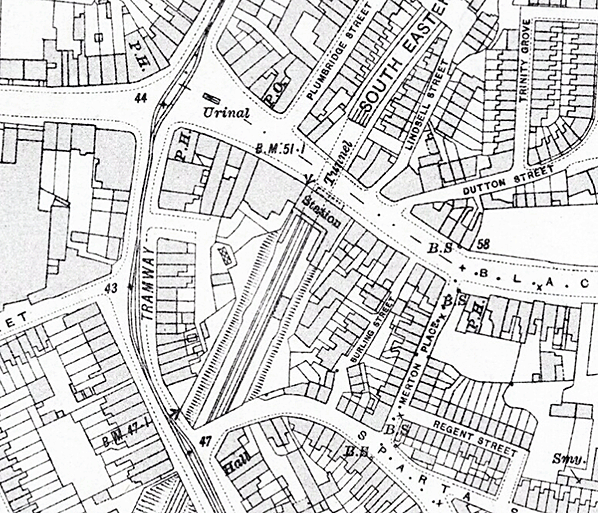
1916 1:2,500 OS map. The station building and footbridge are seen. A waiting shelter in the form of a canopy is seen on the up platform. The signal box to the south of the station has gone. This is the first map to identify the 55yd tunnel to the north of the station.
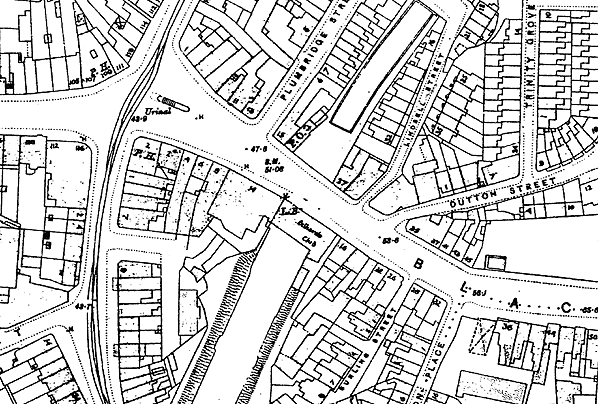
1937 1:2,500 OS map clearly shows the station site after the track was lifted. The tunnel extending north of Blackheath Hill is seen as is the cutting beyond. The station building is shown as a billiard club. Click here for a larger version of this map covering more of the disusewd track bed.
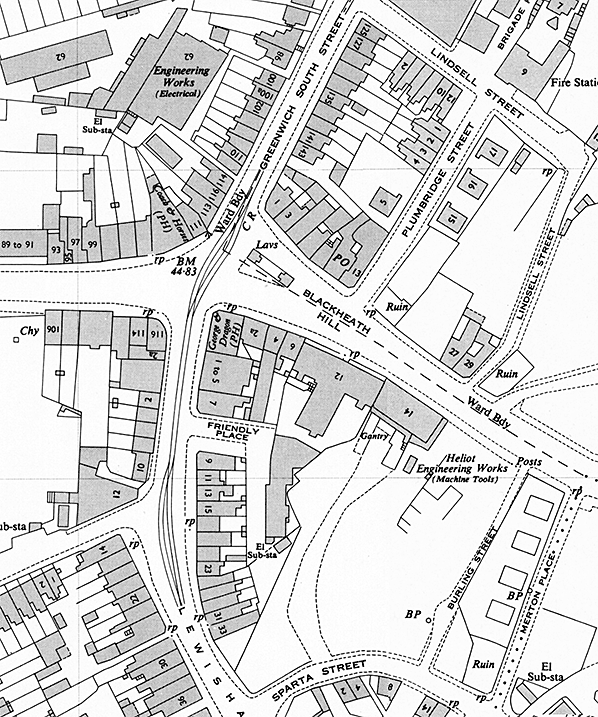 1950 1:2,500 OS map. The station building is now identified as the Helliot Engineering Works. The footbridge and steps on the up side are seen. The entrance to the works is in Sparta Street to the south; this was also the main entrance to the Sparta Street shelter during WW2. The extent of the tunnel on the north side of Blackheath Hill is still clear. Click here for a larger version.
11.jpg)
Looking south-west from Blackheath Hill station in the mid 1920s. The Lewisham Road / Sparta Street bridge is seen at the end of the short platforms and beyond that the Orchard Hill bridge. The signal box was just beyond the Lewisham Road bridge on the right.
Photo from John Mann collection hill20.jpg)
Looking north-west along a virtually traffic-free Blackheath Hill in March 1962. The station building is seen centre left beyond the flats.
Photo by Ben Brooksbank 1.jpg)
Looking north-east at the site Blackheath Hill station in August 1968. The cutting has been filled in and the station building has been extensively rebuilt but the original bridge can still be seen in front
of the building. Photo by Nick Catford 2.jpg) The station frontage on Blackheath Hill in August 1968. The building has been extensively rebuilt in brick but incorporates parts of the original building.
Photo by Nick Catford 12.jpg) Blackheath Hill Station in 1972, taken from a similar viewpoint to the mid 1920s picture above. The station footbridge is seen in front of the building with the slope down into the tunnel. The building and tunnel was, at this time, being used by the Helliot Engineering works. Steps down from the bridge seen on the right might be part of the original covered stairway to the up platform.
Photo by Ian Baker 3.jpg)
Blackheath Hill station building seen from an elevated position in May 1980. The building appears in a derelict state but Mangnal Laminations, were still trading from their workshop in the tunnel below and the east end of the station building has their name above the door and was their office entrance.
Photo by Nick Catford 4.jpg) Looking north along the trackbed from Brookmill Road towards Blackheath Hill in May 1980.
Looking north along the trackbed from Brookmill Road towards Blackheath Hill in May 1980.Photo by Nick Catford Click here for Blackheath Hill Station Gallery 2: June 1987 - July 1987
 Home Page Home Page
|
 The brick and timber-faced street-level building of Blackheath Hill station had a footbridge covered by an awning giving access to covered stairways to the two facing platforms in the cutting below. The platforms ran from Blackheath Hill to Lewisham Road / Junction with Kings Street (later Sparta Street). There was a signal box on the down side of the line south of Lewisham Road. There was a shelter with a canopy on the up platform but maps show no kind of weather protection on the down platform.
The brick and timber-faced street-level building of Blackheath Hill station had a footbridge covered by an awning giving access to covered stairways to the two facing platforms in the cutting below. The platforms ran from Blackheath Hill to Lewisham Road / Junction with Kings Street (later Sparta Street). There was a signal box on the down side of the line south of Lewisham Road. There was a shelter with a canopy on the up platform but maps show no kind of weather protection on the down platform.  The tunnel was divided into two large rooms, the room on the north side of Blackheath Hill being slightly longer than that on the south side; it was necessary to go through one room to reach the other. Each room had triple bunks around the walls with another line of bunks across the centre of the room; the bunks were separated by curtains for privacy. Many local residents spent every night in the shelter during the blitz, often arriving there during the afternoon. They were given regular numbered bunks and were allowed to keep personal belongings in the shelter. There was no segregation between male and female, and families were kept together. The shelter was returned to the Southern Railway on 25 December 1946.
The tunnel was divided into two large rooms, the room on the north side of Blackheath Hill being slightly longer than that on the south side; it was necessary to go through one room to reach the other. Each room had triple bunks around the walls with another line of bunks across the centre of the room; the bunks were separated by curtains for privacy. Many local residents spent every night in the shelter during the blitz, often arriving there during the afternoon. They were given regular numbered bunks and were allowed to keep personal belongings in the shelter. There was no segregation between male and female, and families were kept together. The shelter was returned to the Southern Railway on 25 December 1946.